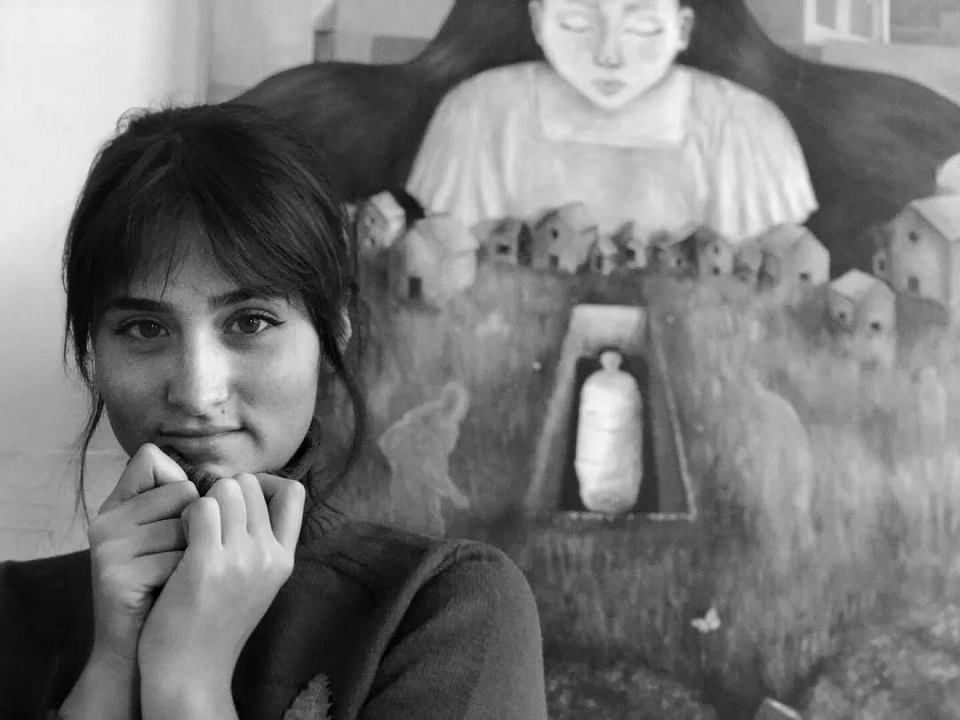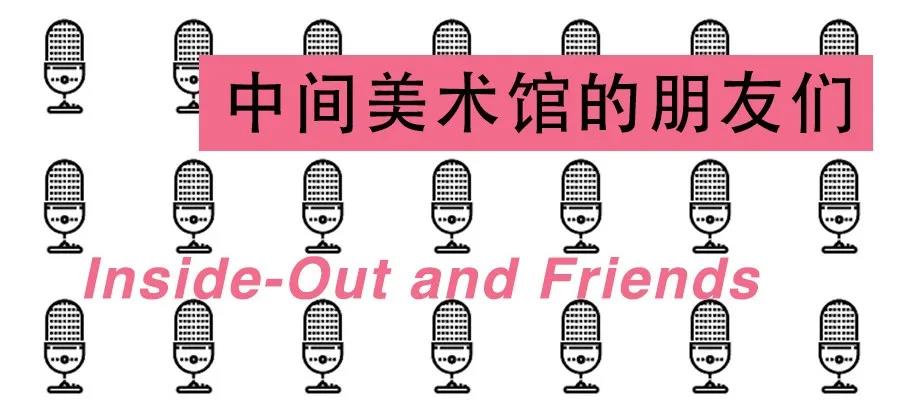中间声音|中间美术馆的朋友们:艾米丽·多切夫(Emily Docheff)

中间声音
上周,“中间声音”栏目翻译转载了德国学者和批评家约尔格·海泽(Jörg Heiser)“‘隔离中的艺术家’,公共知识分子和‘假勇空’的困境”一文,海泽分析并批判在学术和艺术界时下影响相当广泛的“反抗”行为和艺术项目,并提出”小而有意义的行为胜过大而空洞的姿态”。在中国,早已不断涌现出与疫情有关联的艺术作品和项目。许多艺术机构都非常忙碌,从怀疑自己的社会意义与价值,到为经营与盈利而发愁担忧,到摸索开创并玩熟一套新模式,再到重新线上线下双重启动。面对疫情,艺术生产不能停:线上艺术家工作室参访、委任一群艺术家做隔离日记、疫情好转生产恢复后催发出的展览和活动等。艺术界已早早恢复往日的热闹。产生艺术事件、重新建立并持续社会的影响力是艺术机构运行的重要目的和动力,我们也沉沦其中。然而,这些源源不断的生产背后的真实话题却很少被提及:艺术家在疫情期间如何维持自己的收入来源?疫情后我们是重复自己,还是有所不同?今后是否要做得少,做得更好?机构能否切实考虑到展览制作对自然环境造成的影响?这一系列令人已经眼花缭乱的展览项目(甚至和滔滔不绝的公众号推送)是我们在种种不确定性中的思寻与实践,是挑战,更是突破的机会,但也常常使艺术机构陷入海泽批评的“假勇空”的困境,这是我们需要谨慎对待的。
艺术家到底在如何思考?我们诚恳地希望以机构的角色推动多元化的叙述和讨论,同时避免用空洞的的言辞和框架来奴役艺术家。我们联系了过往与中间美术馆合作过的艺术创作者和从业者们,尤其是那些因为疫情下亦实亦虚的城墙反而让我们更加牵挂的人们。这半年来,作为最早受到疫情情影响的国人,眼见一轮又一轮相似的情形在世界各地一次又一次地发生。但时至今日,疫情给我们的普遍感受也许是,面对同一个病毒所引发的政策与对策千差万别。每个区域/国家/群体/个人所采取的措施是如此不同,戴口罩或不戴口罩,居家或出街,停摆休息或维持工作,积极防控或群体免疫。也许现在还太早去评估这些不同措施和手段对未来造成的影响。但如果我们对外面世界的理解只停留在疫情数据与政治宣讲,那我们也许永远无法互相对话和理解。我们向中间美术馆的朋友们发出一封邮件问候,并给他们提供一个没有时间压迫的,可以分享的交流空间。我们尝试不提供不切实际的要求,以自愿与平等沟通的方式,让他们自由发声。由此,我们谦虚地推出“中间声音”(Echoes Inside-Out)栏目单元“中间美术馆的朋友们” (Inside-Out and Friends),与读者和业内同仁分享,欢迎批评。
“中间美术馆的朋友们”第一期,我们分享来自于2019年9至10月在美术馆驻地的美国艺术家艾米丽·多切夫(Emily Docheff)的回信随笔文。她表示,自己并不想马上创作冠冕堂皇的疫情作品。面对疫情导致的生计问题,她重新开始了她在波士顿的绘画教室。与此同时,她也开始研究起非裔艺术家,“摒弃并消除制度上的种族主义旧识需要终身的弥补和赔偿,但是倾听非裔人的声音是免费的”。
(“中间美术馆的朋友们”栏目单元由黄文珑、刘语丝共同构思策划。)
Beijing Inside-Out Museum Working from Home July 2, 2020
Dear __,
From IOAM with love. We are writing to you on behalf of our museum, and we hope you and your family and friends are healthy and safe during this pandemic. Until what has happened in 2020, we have taken for granted a world in which we enjoy ever increasing mobility and movement. The fact that you came all the way to Beijing to share your passion and practice with us becomes more precious than ever before. Your residency ended a while ago, but you are always a part of the IOAM. No matter where you are in this time of uncertainties and difficulties, you are not alone. We are in solidarity with you.
What’s up with IOAM? In Beijing, we are encountering the second wave of COVID-19. Our museum was closed in February, reopened in May, and closed again at the end of June. Meanwhile, we are striving, rethinking, experimenting, and relearning, adapting ourselves to the unpredictable circumstances. Luckily, we managed to open a new exhibition An Impulse to Turn in early June featuring works that include archives or historical themes. We published an anthology entitled China As An Issue and the exhibition catalogue of Dance Only Exists When It is Performed: Yvonne Rainer and Wen Hui. As our physical museum space becomes unavailable, we have been exploring different ways through virtual platforms, such as collaboration with independent self-medias, hosting online lectures, artist conversations, and audio clips.
What’s up with you? Curators are caretakers, and we care not only for art, but artists too. As we have been re-examining art, space, and curation from the perspective of the museum, we would also love to know from your side. We wonder if you would be willing to share some of your thoughts to Chinese audiences and friends in this unprecedented time. We can help to make the content bilingual if necessary, and share it on our social media platforms Weibo, Wechat, and Instagram. It can be reflections, critics, stories in any format, be it text, image, audio, video etc. If you would like to be included, please let us know and we hope to publish the content online later this year.
We look forward to hearing from you, thank you!
Take Care,
Wenlong Huang and Yusi Liu Beijing Inside-Out Museum
来自艾米丽·多切夫的回信

首先,我很感激我能在2019年下半年来到中间美术馆。这个无与伦比的经历使我确信自己迈出了职业生涯的第一步,我在这个全新的环境里充分地学习,倾听,汲取。这个友好的环境不仅培养了我的兴趣,也让我结识了新的朋友。我感到很幸运能够有这样的经历,尤其是现在知道了全球疫情的影响和后果。
在美国,我所居住的州自三月份发布并实施了居家令。一些员工为了保障自身安全,甚至不得不为了关闭公司企业而斗争,争取权益。如很多其他人一样,我自己也开始逐渐对失业和财务压力有了更切身地了解。这是一种崭新的日常生活,在这样单调而又慢慢无期的等待中,生活仍然充满不可预测性。我的母亲记得她第一次为了买菜而必须离开家的时候——平常这都是我父亲的工作,但是因为他免疫力低下而需要待在家中。当看到所有人被口罩遮住的脸时,她内心生出一种新的恐惧,那是一种她以前从未了解过或是感受过的恐惧。她记得当她回到车上摘下口罩后,她自己也不知道为何缘故地哭泣。
最近在美国引发的抗议示威是从5月26日开始的,就在乔治·弗洛伊德之死的第二天。没有携带任何武器的46岁非裔男子弗洛伊德,在明尼苏达州其他警察的注视下,被一名警察用膝盖顶住脖子超过8分钟后死亡。新闻和互联网随即曝光了事发录像中警方的残忍行径,以及更多无辜非裔枉死的事件,例如警方私闯民宅枪杀了在睡梦中的26岁非裔女性布伦娜·泰勒(Breonna Taylor);警察因“可疑”为由在马路上拦住并袭击了23岁的非裔男性伊利亚·麦克莱恩(Elijah McClain),最终麦克莱恩因被过量注射氯胺酮在医院脑死亡。当然,还有无数其他类似遭遇的人。
2014年,当双手举过头顶的18岁青年迈克尔·布朗(Michael Brown)被警方射杀,“黑人的命也是命”运动就开始在主流媒体中传播。如今,这一运动在全球疫情当中逐渐壮大,迫使我们去看清什么才是重要的,也迫使长久以来不知进取的美国人学会面对我们国家几百年来的种族主义劣根。但是,我从未见过我今日所见的分裂。那些拒绝去反思仇恨的声音在增长。我们的领导人利用种族主义和厌女症传播这样的仇恨使国家分裂。从六月开始,至少有五个非裔变性女性在美国被害。每天似乎都有新的消息加重我们的害怕。我们该如何在自我隔离时期处理内心的不安全感和绝望?如何能够在这些互相矛盾的事件中理出头绪?又该如何在自我隔离的高墙内表现出团结和信心?
作为一个艺术家,也作为一个个体,很容易陷入一种担忧和不安当中。但对我来说,艺术家应该去理解和回应我们所面对的社会与政治变化。我们常常透过早先艺术家的作品来与历史中的变迁和革命进行联系,视觉化那些未被听到的声音,或是获得我们无法身临其境去看到的视角。因此,艺术家也身担重任,不仅要创作关于这段绝望的时代的作品,也需要全然去理解时代本身,与及其复杂又多变的现实交流。当你的思考和创作与当下的社会与政治无关时,便会很容易陷入一种罪恶感中。我怎么能在众人受苦的时候还创作这样的作品?我怎么能在人们都在受苦的时候还去创作?我所做的是否能让那些未被听到的声音被听见?我所做的能不能帮助那些需要被听到的声音得到关注?因此,艺术表达上的失败便成为一个主张表达的失败。在全球封锁和种族革命期间,因艺术的停滞或艺术的失败所产生的压力从绘画创作渗透到了停歇止息中——当你晓得休息实际上是一种特权。
我的绘画创作是非常个人的,并与我的个人经验和所思所梦息息相关。虽然对我来说绘画仍然是一种宣泄的必要行为,但我认为我的创作并不是现在人们需要看到的。近期,我致力于倾听和学习一些非裔艺术家和作者的作品,比如罗娜·辛普森(Lorna Simpson),亚瑟·贾法(Arthur Jafa),克劳迪娅·兰金(Claudia Rankine),阿德里安·布兰登(Adrian Brandon),基思·华盛(Keith Washingtong),凯里·詹姆斯·马歇尔(Kerry James Marshall)和卡莉达·罗尔斯(Calida Rawles)。摒弃并消除制度上的种族主义的旧识需要终身的弥补和赔偿,但是倾听非裔人的声音是免费的。
有这些想法占据在我的脑海,再加上新冠疫情在美国未可预见的结局,我想现在的我还没有全部的答案,甚至还没有发现全部的问题。直到我们能够成为一个共同体之前,我仍然在吸收、思考和倾听。在被疫情隔离与过载信息对我们生活的消耗下,寻找希望也许看起来很难,但幸运的是,有许多的行动正在发生。即使我目睹我的国家仍然如此分裂,但我能够看到数不胜数的爱出现在艺术作品中、歌曲中、小提琴声中、演讲中以及强有力的发声中。艺术是充满力量的,它不仅能够传达信息,更能传递希望——它使我终于能够离开自我,享受其中。
艾米丽·多切夫 2020年7月23日
[1]https://interactive.aljazeera.com/aje/2020/know-their-names/index.html [2]https://www.hrc.org/resources/violence-against-the-trans-and-gender-non-conforming-community-in-2020 因版权问题,我们无法在此分享艾米丽提供的信中所提及的非裔艺术家和作者的作品图片,链接如下。罗娜·辛普森(Lorna Simpson):https://www.icaboston.org/exhibitions/we-wanted-revolution-black-radical-women-1965–85; 亚瑟·贾法(Arthur Jafa):https://www.moca.org/exhibition/arthur-jafa-love-is-the-message-the-message-is-death; 克劳迪娅·兰金(Claudia Rankine):https://www.arts.gov/national-initiatives/nea-big-read/citizen-an-american-lyric; 阿德里安·布兰登(Adrian Brandon):https://www.adrianbrandon.com/stolen; 基思·华盛(Keith Washington):https://www.keithmorriswashington.com/within-our-gates; 凯里·詹姆斯·马歇尔(Kerry James Marshall):https://www.metmuseum.org/art/collection/search/668330;卡莉达·罗尔斯(Calida Rawles):https://www.calidagarciarawles.com/。


艾米丽·多切夫的Instagram
I would first like to acknowledge how grateful I am to have been able to visit the IOAM in Beijing late in 2019. It truly felt like my first step into a career, not to mention an incredible experience filled with learning, listening and absorbing a place entirely new to me. A place that welcomed me, nurtured my interests, and introduced me to new friends. I feel lucky to have this experience when I did, knowing now the effects of the ensuing pandemic.
In my state in the U.S., stay-at-home orders began in March. Several employees had to fight for their businesses to close in the interest of their safety. Myself, like many others, began the learning process of unemployment and financial stress. Daily life became brand new and somehow still unpredictable in our mundane state of constant waiting. My mother recalls the first time she needed to leave the house for groceries–usually my father’s job but he remained at home, immunocompromised. The fear she felt in everyone’s masked face was a new fear. One she hadn’t known or felt before, and when she returned to her car and removed her mask she recalls sobbing without knowing why.
Recent protests in the U.S. began May 26th, the day after the death of George Floyd, an unarmed 46-year-old black man who was killed during an arrest after a police officer knelt on his neck for nearly 8 minutes while other Minneapolis officers looked on. The news and internet exploded with footage of police brutality and ignored stories of innocent black lives lost. Other names became icons for the movement such as Breonna Taylor, a 26-year-old black woman shot multiple times while she lay sleeping in her home by police during an illegal, unannounced home-raid; and Elijah McClain, an unarmed 23-year-old black man known for playing his violin for shelter animals, was attacked by police on his walk home for fitting a suspicious description and was eventually injected with ketamine, causing him to pass away days later in the hospital, declared brain-dead from the lethal dose. And, of course, there are countless other names.[1]
The Black Lives Matter movement has been heard in the popular news since 2014, when 18-year-old Michael Brown was shot with his hands up in my home state. Now, it thrives in the midst of a global pandemic, forcing us to look at our priorities and prompting the life-long unlearning Americans must do in order to understand centuries of the racism that built our country. However, I have never seen the kind of division I see now. The volume of voices that refuse to address their hatred grows. The leader of my country spreads this hate, using racism and misogyny as an in with a divided country. Since this June, at least 5 black trans women have been murdered in the U.S.[2] Everyday it seems some new piece of information arises to worsen our fears. What do we do with the feelings of insecurity and despair while we remain distanced? How do we prioritize completely conflicting issues? How do we show solidarity and confidence behind walls?
As both an artist and a person, it is easy to dissolve into a cycle of fear and guilt. One thing that has been ingrained in me is that artists are meant to understand and respond to social or political change. We often look to past artists’ work as a way to connect with historical change or revolution–to visualize voices unheard or gain perspective on something we weren’t close enough to see ourselves. Thus, an intense pressure arises in the artist to not only create work about desperate times, but to fully understand them. To be able to communicate an intensely complicated and ever changing present. To think of your work outside of the sociopolitical bubble you find yourself in becomes an action shrouded in guilt. How can I make work like this while people suffer? Is what I’m doing calling attention to voices needing to be heard?
Then, of course, failure in your art becomes a failure to advocate.
The pressure involved with artistic stasis or failure during global lockdown and racial revolution leaks beyond painting and into moments of rest–knowing it is a privilege to rest at all.
My work as a painter is extremely personal, delving into my own experiences, headspace, and dreamspaces. While it is still a cathartic and necessary action for me, I’ve decided that my kind of artwork may not be what people need to see right now. More recently, I’ve dedicated time to listen and learn from the work of black artists and writers. Lately, Lorna Simpson, Arthur Jafa, Claudia Rankine, Adrian Brandon, Keith Washington, Kerry James Marshall and Calida Rawles. Unlearning institutional racism will take an eternity of reparations, but listening to black voices is free.
With this at the forefront of my mind, and with the COVID-19 pandemic having no foreseeable end in the U.S., I’m content in myself to say that I don’t have all the answers or even all the questions right now. I am still absorbing, thinking, and listening until we all get there together. It may be difficult to find hope when so much isolation and digital heaviness consumes our lives. Luckily, there is an incredible amount of action happening. While I still have seen my nation so divided, I have also seen outpourings of love–artwork, songs, violin vigils, powerful speeches, strong voices. Art is a powerful tool for information as much as it is for hope–something I’ve been able to enjoy once finally stepping away from myself.
Emily Docheff 07.23.2020
[1]https://interactive.aljazeera.com/aje/2020/know-their-names/index.html [2]https://www.hrc.org/resources/violence-against-the-trans-and-gender-non-conforming-community-in-2020


发表回复